On June 8, 2014, at the Archeon History Museum in the Netherlands, jousters Wouter Nicolai and Bertus Brokamp of Stichting HEI did a demonstration of a 'joust at large' -- a joust without a tilt. Jousting without a tilt is dangerous, even for experienced jousters(though much practice reduces the danger). Wouter Nicolai has been chosen as Most Chivalrous in several of the tournaments he has competed in, including the recent St Hallvard's Tournament 2014 and the Tournament of the Phoenix 2013. I asked Wouter to write something about his experiences doing the joust at large, and he kindly sent me the following text. Photographers Hans Splinter and Ronin Photography were kind enough to allow me to use their photographs to illustrate the text.
Written by Wouter Nicolai:
The joust at large is one of the tournament forms we have been talking about for a long time, but one that we had never actually tried. The joust at large (or “at random”) is a jousting form done without a tilt, usually followed directly by a melee with the sword. It was done in field armour, using sharp lances and, in most cases, shields.
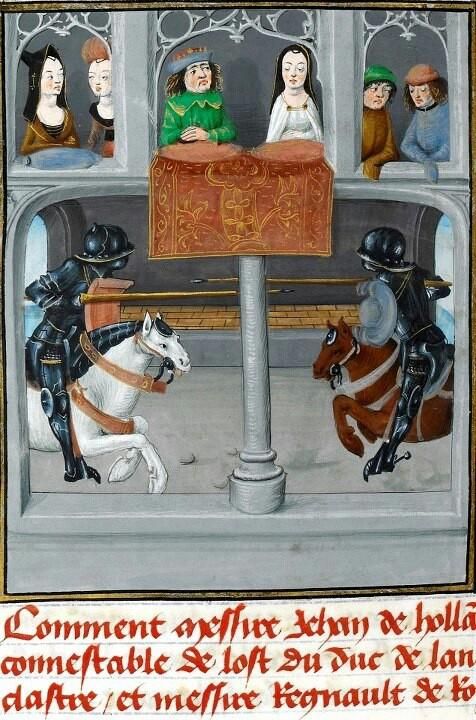
A joust without a tilt between Sir John Holland and Regnault de Roye, from Jean de Wavrin, Les Choniques d' Angleterre (image provided by Wouter Nicolai)
To me the joust at large is fascinating, because of its simple and straightforward approach. Despite the dangers of the joust itself, this could be done on almost every field with little preparation (of the list). It also seems a very feasible way of organising a small joust by a local squire or knight in the 15th century. We have chosen to present this joust as a pas d'armes because the concept of a challenger and a defendant resonates with the audience, and it is a good format to convey a very real historical context for jousting, needing no more than a small crew and two riders.
Bertus and I have been doing historic jousting demonstrations for years, mainly in the open air museum Archeon in the Netherlands, in these demonstrations we show skill at arms with sword and lance, jousting and melee. Our experience in working together has given us a good starting point for developing this new demonstration of a joust without tilt.
Our demonstration has three parts: First, we start with the challenge to introduce the concept of a pas d' armes to the audience and explain how and why such tournaments were done. The challenge starts with the defendant declaring the pas, and the challenger declaring the challenge. Second, we do the skill at arms with runs on the quintain, as the lance is a knight's primary weapon. In our try-out show, this was a simple shield on a stick, so we could easily remove it before the joust.
The next part is with the sword, where the rider encircles cabbages or watermelons and shows different sword techniques. Third, we do the joust itself in two rounds. Both rounds starting with the lance and moving on with a melee weapon (sword or club). We keep fighting until one rider surrenders.
How we do the joust:
Although most if not all readers will understand how dangerous jousting without a tilt can be, I do want to emphasise: Don't go and casually try a joust at large, it is very dangerous! We have spent a lot of time and effort on proper training before we considered ourselves ready for this challenge.
In a way the runs of joust at large are no different from a charge in the melee, but there are some other factors that play a role in doing a successful pass. The angle in which you approach the opponent is more critical with the lance, especially when using an arret. In general there is less room to manoeuvre due to the length and off-balance of the lance.
In the runs, I try to keep the horse in a slow canter and only speed up when I am certain I am in range and not in risk of getting too close. Adjustment of the distance to the opponent happens by sideways incline, not by changing the direction of the run.
For the first joust, we positioned two cabbage-cutting posts in the track of the run to use as a guide. This did not work because a run without tilt is done differently than on a tilt. Without a tilt, we are constantly adjusting our position sideways, which clearly does not align to a straight track. Once we moved the posts we got much closer, but only close enough to score a few attaints.
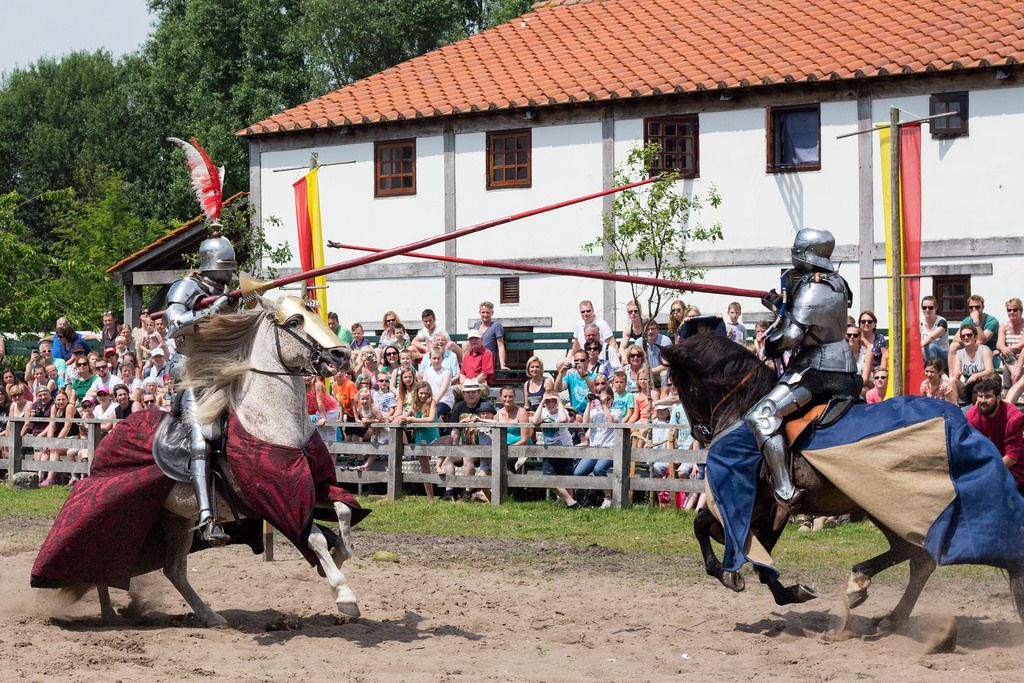
Wouter Nicolai(left) and Bertus Brokamp(right) joust without a tilt at Archeon 2014
(photo by Hans Splinter)
The equipment:
The lances we use for the joust at large are a bit lighter than the lances we normally use. We use poplar inserts, which behave a bit more like real lances than balsa inserts. They are harder to break, and more important (for the audience) is that they make more noise when they hit. The downside of the poplar insert is that if you cannot get close enough you cannot break. We decided that the more realistic sound of an impact was more important than easy breaking.
The first round of melee is done with blunt swords. The sword melee is fought in a more technical way than the club melee, because fighting with swords on horseback is more dangerous and very destructive to armours. The swords are similar to what re-enactors use, although I use a sword which was specifically designed to use in the mounted melee. It has a thicker and more rounded cutting edge (5mm) and is shaped like the swords drawn in Rene d' Anjou's tournament book.
The clubs are made from a hard rubber, although we will probably use wooden clubs for future demonstrations. They allow us to fight in a more violent way, with less risk of injuring our opponent.
The joust and melee are done in field armours and helmet. We do not have time to change helmets or visors between the joust and melee. The visors of the sallets are locked down with a bolt, to make sure they will not open on the impact of a weapon.

Bertus Brokamp(left) and Wouter Nicolai(right) fight with clubs during a mounted melee
(photo by Hans Splinter)
The shield for this kind of tournament, should be a single curved one, rather than the saddle curve shields we use for the shaped solid lances (i.e. joust of peace). The shield is intended to catch the lance rather than to deflect it. In the photos I am using the saddle curve shield, this was because my war shield was not yet ready to use. It is not an appropriate shield for this style of jousting.

Bertus Brokamp(left) and Wouter Nicolai(right) continue to wear their shields during the melee. Bertus' shield (blue and white) has a single concave curve around a horizontal axis, the correct style of shield for the joust at large. Wouter's shield (gold, black & white) is a saddle curve shield, it curves concavely around a horizontal axis and also curves convexly away from a vertical axis which goes down the center of the shield(like the prow of a ship). This type of shield is not ideal for the joust at large (photo by Hans Splinter)
A last bit of equipment we use to add more safety and historical accuracy is the arret d'cuiras(lance rest). A properly used arret has some advantages. First of all it forces a rider to use a proper historic technique in handling his lance, which is a vertical drop and a precise method of couching it. This keeps the lance tip in the air and out of the way. It also stabilizes the lance during the run, which helps the rider to focus more of his attention to riding his horse.

You can see the arret(lance rest) on the right side(his right) of Bertus Brokamp's armour
(photo by Ronin Photography)
Our joust at large demonstration will once again be done at the Gebroeders van Limburg Festival in Nijmegen (the Netherlands), August 30-31, 2014, and next year in the open air museum Archeon (the Netherlands), May 24-25, 2015.
Related articles:
Joust for Fun: A Knight and his Axe
The Jousters of St Hallvard's Tournament
Jarek Struczynski Wins the "Tournament of the Phoenix 2013"
Written by Wouter Nicolai:
The joust at large is one of the tournament forms we have been talking about for a long time, but one that we had never actually tried. The joust at large (or “at random”) is a jousting form done without a tilt, usually followed directly by a melee with the sword. It was done in field armour, using sharp lances and, in most cases, shields.

A joust without a tilt between Sir John Holland and Regnault de Roye, from Jean de Wavrin, Les Choniques d' Angleterre (image provided by Wouter Nicolai)
To me the joust at large is fascinating, because of its simple and straightforward approach. Despite the dangers of the joust itself, this could be done on almost every field with little preparation (of the list). It also seems a very feasible way of organising a small joust by a local squire or knight in the 15th century. We have chosen to present this joust as a pas d'armes because the concept of a challenger and a defendant resonates with the audience, and it is a good format to convey a very real historical context for jousting, needing no more than a small crew and two riders.
Bertus and I have been doing historic jousting demonstrations for years, mainly in the open air museum Archeon in the Netherlands, in these demonstrations we show skill at arms with sword and lance, jousting and melee. Our experience in working together has given us a good starting point for developing this new demonstration of a joust without tilt.
Our demonstration has three parts: First, we start with the challenge to introduce the concept of a pas d' armes to the audience and explain how and why such tournaments were done. The challenge starts with the defendant declaring the pas, and the challenger declaring the challenge. Second, we do the skill at arms with runs on the quintain, as the lance is a knight's primary weapon. In our try-out show, this was a simple shield on a stick, so we could easily remove it before the joust.
The next part is with the sword, where the rider encircles cabbages or watermelons and shows different sword techniques. Third, we do the joust itself in two rounds. Both rounds starting with the lance and moving on with a melee weapon (sword or club). We keep fighting until one rider surrenders.
How we do the joust:
Although most if not all readers will understand how dangerous jousting without a tilt can be, I do want to emphasise: Don't go and casually try a joust at large, it is very dangerous! We have spent a lot of time and effort on proper training before we considered ourselves ready for this challenge.
In a way the runs of joust at large are no different from a charge in the melee, but there are some other factors that play a role in doing a successful pass. The angle in which you approach the opponent is more critical with the lance, especially when using an arret. In general there is less room to manoeuvre due to the length and off-balance of the lance.
In the runs, I try to keep the horse in a slow canter and only speed up when I am certain I am in range and not in risk of getting too close. Adjustment of the distance to the opponent happens by sideways incline, not by changing the direction of the run.
For the first joust, we positioned two cabbage-cutting posts in the track of the run to use as a guide. This did not work because a run without tilt is done differently than on a tilt. Without a tilt, we are constantly adjusting our position sideways, which clearly does not align to a straight track. Once we moved the posts we got much closer, but only close enough to score a few attaints.

Wouter Nicolai(left) and Bertus Brokamp(right) joust without a tilt at Archeon 2014
(photo by Hans Splinter)
The equipment:
The lances we use for the joust at large are a bit lighter than the lances we normally use. We use poplar inserts, which behave a bit more like real lances than balsa inserts. They are harder to break, and more important (for the audience) is that they make more noise when they hit. The downside of the poplar insert is that if you cannot get close enough you cannot break. We decided that the more realistic sound of an impact was more important than easy breaking.
The first round of melee is done with blunt swords. The sword melee is fought in a more technical way than the club melee, because fighting with swords on horseback is more dangerous and very destructive to armours. The swords are similar to what re-enactors use, although I use a sword which was specifically designed to use in the mounted melee. It has a thicker and more rounded cutting edge (5mm) and is shaped like the swords drawn in Rene d' Anjou's tournament book.
The clubs are made from a hard rubber, although we will probably use wooden clubs for future demonstrations. They allow us to fight in a more violent way, with less risk of injuring our opponent.
The joust and melee are done in field armours and helmet. We do not have time to change helmets or visors between the joust and melee. The visors of the sallets are locked down with a bolt, to make sure they will not open on the impact of a weapon.

Bertus Brokamp(left) and Wouter Nicolai(right) fight with clubs during a mounted melee
(photo by Hans Splinter)
The shield for this kind of tournament, should be a single curved one, rather than the saddle curve shields we use for the shaped solid lances (i.e. joust of peace). The shield is intended to catch the lance rather than to deflect it. In the photos I am using the saddle curve shield, this was because my war shield was not yet ready to use. It is not an appropriate shield for this style of jousting.

Bertus Brokamp(left) and Wouter Nicolai(right) continue to wear their shields during the melee. Bertus' shield (blue and white) has a single concave curve around a horizontal axis, the correct style of shield for the joust at large. Wouter's shield (gold, black & white) is a saddle curve shield, it curves concavely around a horizontal axis and also curves convexly away from a vertical axis which goes down the center of the shield(like the prow of a ship). This type of shield is not ideal for the joust at large (photo by Hans Splinter)
A last bit of equipment we use to add more safety and historical accuracy is the arret d'cuiras(lance rest). A properly used arret has some advantages. First of all it forces a rider to use a proper historic technique in handling his lance, which is a vertical drop and a precise method of couching it. This keeps the lance tip in the air and out of the way. It also stabilizes the lance during the run, which helps the rider to focus more of his attention to riding his horse.

You can see the arret(lance rest) on the right side(his right) of Bertus Brokamp's armour
(photo by Ronin Photography)
Our joust at large demonstration will once again be done at the Gebroeders van Limburg Festival in Nijmegen (the Netherlands), August 30-31, 2014, and next year in the open air museum Archeon (the Netherlands), May 24-25, 2015.
Related articles:
Joust for Fun: A Knight and his Axe
The Jousters of St Hallvard's Tournament
Jarek Struczynski Wins the "Tournament of the Phoenix 2013"

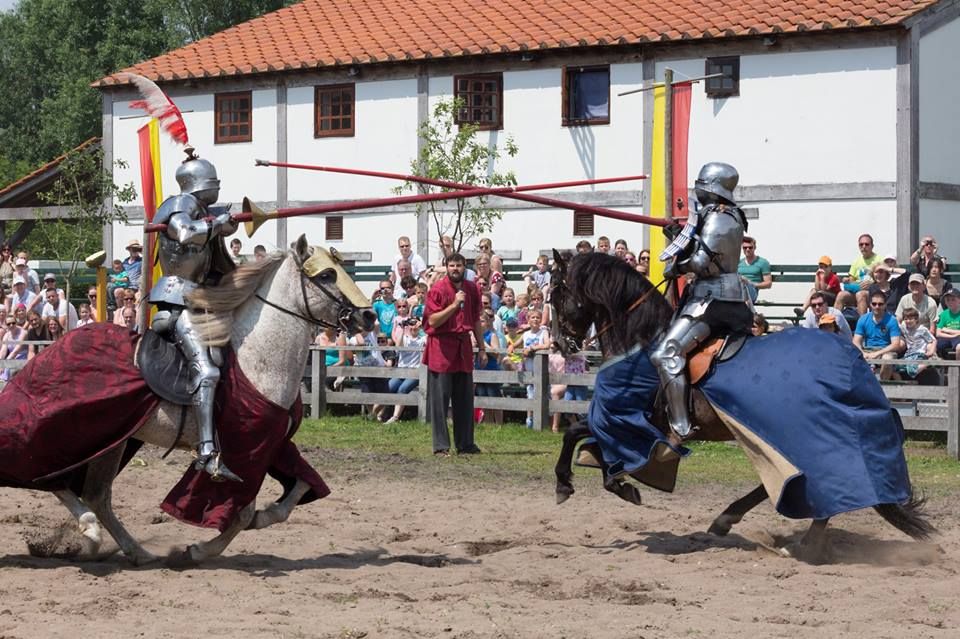


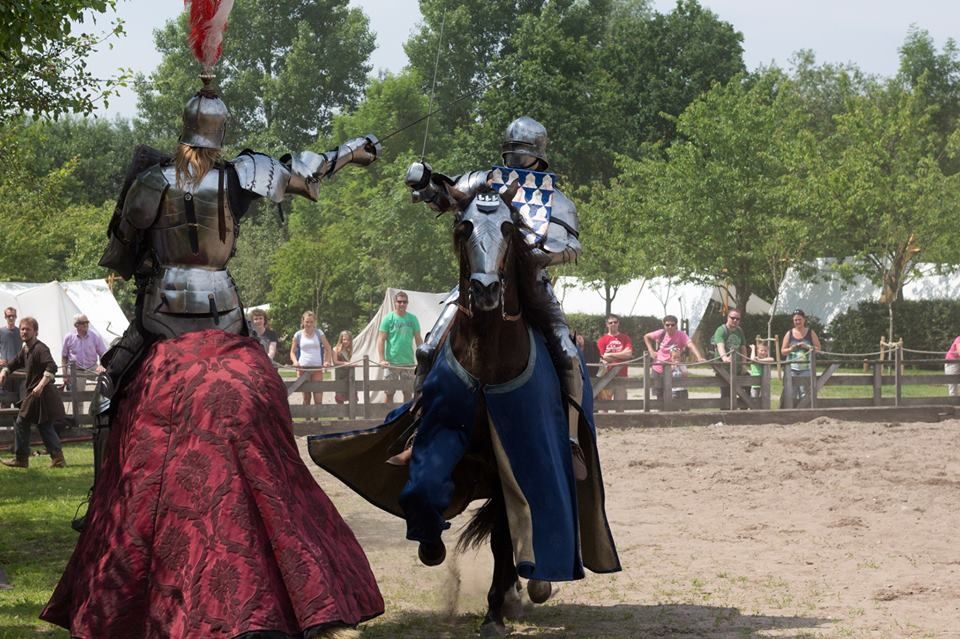
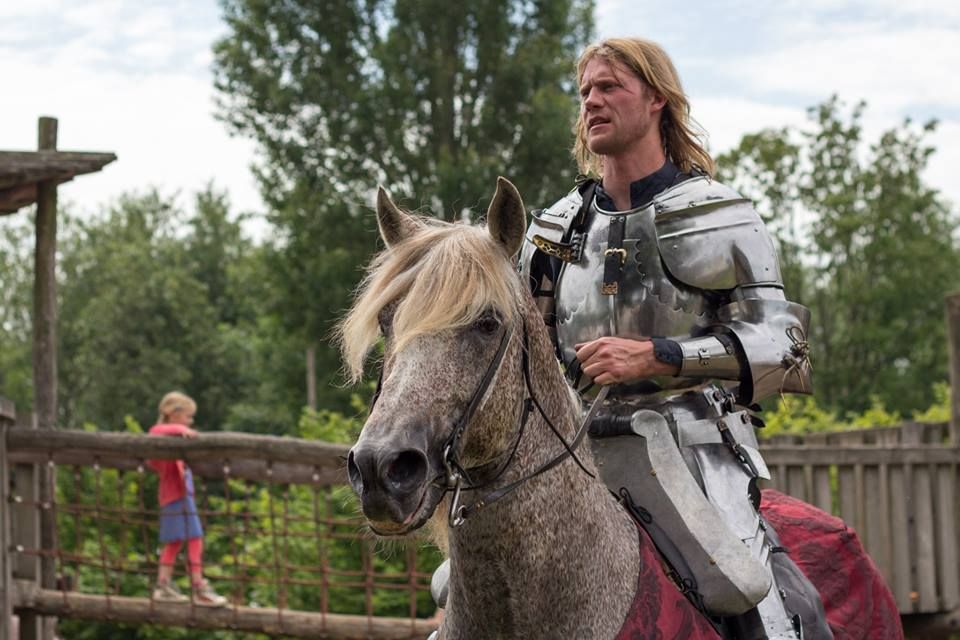
No comments:
Post a Comment